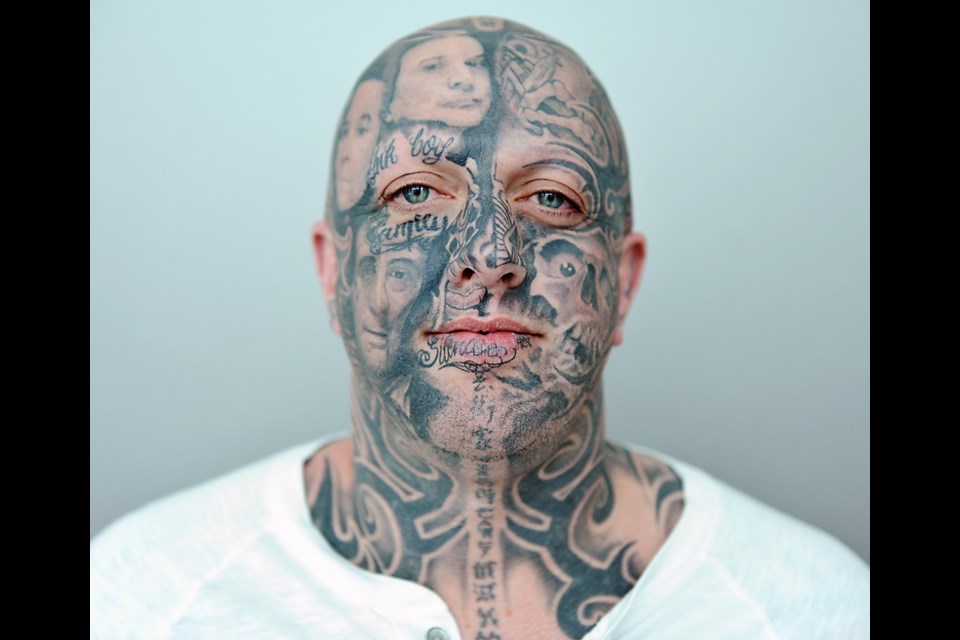At one end of the sound spectrum at the Vancouver Tattoo and Culture Show this past weekend was the carnival barking coming from the stage where pin-up girls wiggled in military-inspired dresses. At the other end of the spectrum was the mosquito-buzz of a hundred tattoo machines.
Many of the city’s artists had a table or three set up in their booths at the Vancouver Convention Centre, hunched over living canvases of skin, painting on clients zoned out to the fact that they were getting inked in a convention centre along with dozens of others at the exact same time. There was a certain poetry to the sound of creation, the synchronicity of machine meeting flesh.
“You have these moments where you realize so many tattoos are being created at once,” said Chris Hold, who works out of Vancouver shop Sacred Heart Tattoo. “I was here until 11 p.m. last night and we were closing down. I was running my machine and I could hear somebody else running their machine in the distance — zzzzpt, zzzzpt — it was like smoke signals or something.”
It’s the sixth year for the show formerly known as the WestCoast Tattoo and Culture Show headed by Tim Lajambe. Stephanie Vu helped out with production as she knows Lajambe through the world of metal fabrication where he is her mentor.
“This is in between a boutique and a big show,” said Vu. “I moved to Vancouver from California and while there’s obviously more people there, it seems that here everybody is tattooed. It’s not even an uncool thing or a cool thing, it’s just a normal thing. So, there’s a massive community and it’s very diverse and we try to cater to that.”
In addition to the more than 120 local and international artists, there was a seminar on lettering, both pin-up and Dead Dollz zombie pageants, as well as an artist and people’s choice contest. Attendees proud of their work competed in the latter competition, an informal process where winners were selected based on cheers from the audience.
Of the six who signed up for the Poor Life Choices category, only one appeared. It was an automatic win for his entry — an eternity tattoo accompanied by a saying unfit for a family newspaper. He walked off the stage with a cash prize of $50, fished out from host Samantha Mack’s bosom.
Back at the booths, Hold sketched artwork for one of his regular customers while explaining that part of the appeal of getting inked at a show is being able to compare and choose styles under one roof without having travel costs.
“There’s an excitement around collecting work and it’s a cheap way to get a tattoo from somebody who’s desirable,” he said. Hold had his own experience on the other side, once lucking out at a show in Seattle where he discovered the artist he happened to be talking to was San Jose’s Matt Shamah, whose work he greatly respects.
“We were talking about hockey — he knows more about Vancouver hockey than I do — as I was looking through his portfolio and I didn’t know it was him. He wasn’t advertised to be there,” remembered Hold. “So he agreed to do a tattoo. I had no money at all and I don’t know why he did it, I guess he was bored but it was awfully generous.”
Hold has a background in design, including teaching at Langara College. He’s also worked in a dairy along with a long list of bill-paying Joe jobs, part of the reason he feels privileged to be working as a full-time tattoo artist.
“All those guys who tattooed in the early years didn’t do it full-time. They’d be a UPS delivery man, barber, or whatever it might be.
Then they’d tattoo from 8 p.m. to two in the morning to make extra money now and then. When I think about those guys, it makes me feel fortunate that I came at it at a time when I can wake up and do it every day,” he said.
It’s the history of the art that Hold also respects about the industry.
“There’s the primal, historic evolution of tattooing. It comes from primitive marks, it’s ritualistic, ceremonial and evolved into something dark — men that fought, killed… criminals… Then look at the military and the First and Second World War where they were badges accepting that you were possibly going to die but also represented the camaraderie and brotherhood,” he said.
“It meant something. But now, it’s like makeup. And that’s fine but it’s not where it comes from. It comes from a really dark, primal, scary place.”
rblissett@telus.net



